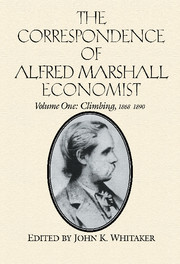General Introduction
Published online by Cambridge University Press: 29 March 2010
Summary
Alfred Marshall, eminent English economist and founder of the ‘Cambridge School of Economies’, was born in 1842 and died in 1924. His heyday proved to be the decisive period in the establishment of economics as science, as profession, and as academic subject. His own contribution to each of these developments was major.
The familiar selection from Marshall's correspondence included in Memorials of Alfred Marshall in 1925 has proved an invaluable and frequently invoked source of insight. Less laboured, less painfully qualified, and certainly less inhibited, than his carefully wrought publications, these letters have long added new dimensions to the understanding of his life, thought, aims, and character. Since 1925, further items from Marshall's correspondence have been published, and even more have been quoted and offered as telling evidence. A comprehensive edition of the extant correspondence seems, in the words of the late Lord Robbins, an ‘essential desideratum’ for Marshall scholarship. Precedent for such an enterprise exists in the similar editions already published for major economists of Marshall's era, such as William Stanley Jevons, Léon Walras, or Vilfredo Pareto. More general justification might be found in the peculiar ability of informal correspondence to reawaken dead voices, to illumine character, mindset, and personal relationships, and to provide valuable insights to biographer, exegete, and intellectual historian.
The preparation of a comprehensive edition of correspondence requires, in the first instance, that the pertinent documentary raw material be assembled. This assemblage proved no mean task in Marshall's case. He appears to have made no systematic effort to preserve letters received or retain copies of letters sent.
- Type
- Chapter
- Information
- The Correspondence of Alfred Marshall, Economist , pp. ix - xiiPublisher: Cambridge University PressPrint publication year: 1996

